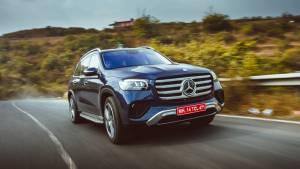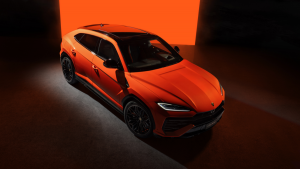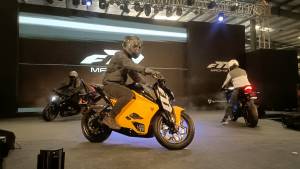2020 Mercedes-Benz GLS-Class first drive review
This year, Mercedes-Benz India is all set to replace its range-topping luxury SUVs, the GLE and the GLS, with all-new models. We drove the GLE in Texas last November and this month we visited Utah to have a go at the third-generation GLS with both its India-bound engines present for us to drive.
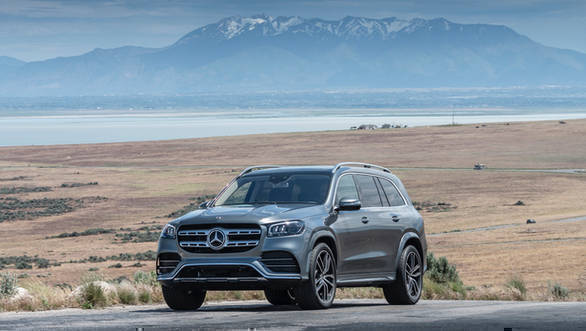 The Mercedes is now in its third generation and features new-age technology under the hood that pushes the envelope further for full-size luxury SUVs
The Mercedes is now in its third generation and features new-age technology under the hood that pushes the envelope further for full-size luxury SUVs
Why the US?
For starters, Mercedes-Benz produces the GLE and the GLS in Tuscaloosa, Alabama, in the United States and therefore it is logistically easier for the carmaker to give us an early sampler of what is coming. Secondly, Utah is known for its rocky terrain, some wide highways, stunning mountain roads, scarce traffic, and of course, its motorsport affinity. It's a pity that after landing in the Salt Lake City, we didn't drive the new GLS on the rocky trails of Moab or on the horizon-blurring straights of the Bonneville Salt Flats. But even if we did, the new GLS could easily lift itself and crawl over the trails, or blast down the salty straights without breaking a sweat.
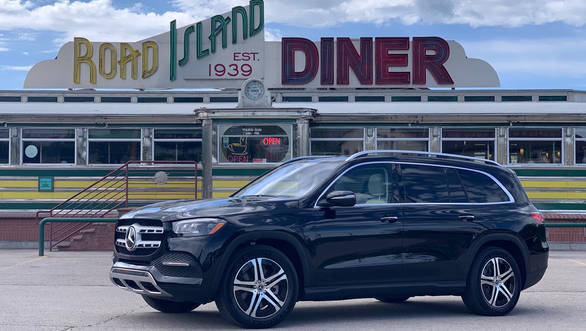 We drove the GLS 580, the GLS and the GLS in the state of Utah in the USA
We drove the GLS 580, the GLS and the GLS in the state of Utah in the USA
The magic of active suspension
Like the GLE, the GLS too features the Electronic Active Body Control, or E-ABC, which gives this mammoth the ability to dance. Not a pretty sight, yes, but it's a pretty good feature to have. When With the E-ABC, the GLS has the ability to actually lift either of its four corners by an additional 60mm, when instructed! This ability comes courtesy of a 48V electronic system, which allows the individually controlled air-springs to make several damping changes and alter ride at either or all four wheels. Regular air-suspension or adaptive dampers simply can't act or react as quickly.
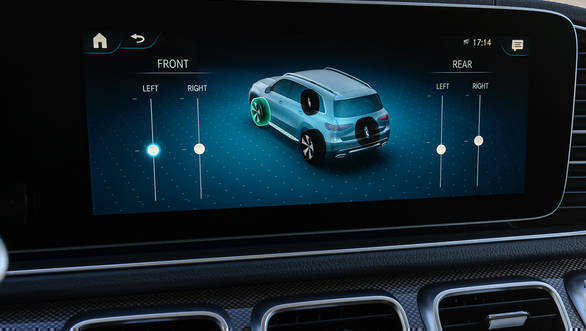 The E-ABC allows the user, individual control over all the four corners, and either of the corners can then be raised by up to 60mm!
The E-ABC allows the user, individual control over all the four corners, and either of the corners can then be raised by up to 60mm!
The real world advantage of this is in the GLS' ride. Like the fabled magic carpet ride of the new S-Class, the GLS too uses a set of radars, lidar and cameras to scan the surface of the road ahead and make constant damping changes to the suspension in order to be prepared and cope with an upcoming dip, bump or undulation. The speed and efficiency of new-age sensors help the GLS surpass the S-Class and bring this surface-scanning capability to mild off-road trails as well. And it works! We accelerated down a gravely, moderately undulated road in Comfort mode and the GLS managed to maintain an unexpected and a pleasantly surprising flat ride. A cool animation on the large infotainment screen also shows you the movement of each wheel.
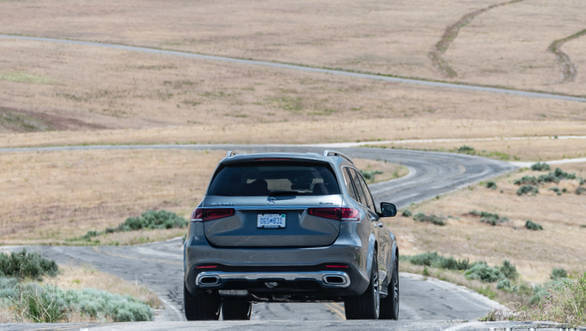 Air-suspension is standard on the GLS and there is the optional Electronic Active Body Control active suspension which comes courtesy of a 48V electronic system
Air-suspension is standard on the GLS and there is the optional Electronic Active Body Control active suspension which comes courtesy of a 48V electronic system
The E-ABC works at highway speeds too and takes away the firm edge or the overly squishy nature that we usually experience with the various German SUVs. The E-ABC impresses further around the winding roads with its curve function. Apart from stiffening up the suspension setup for the curves, it also helps the car tilt into the turn - like a motorcycle, to put things into perspective. It seems a bit unnecessary in an SUV, but the advantage is that you don't get too much vertical movement, despite the size.
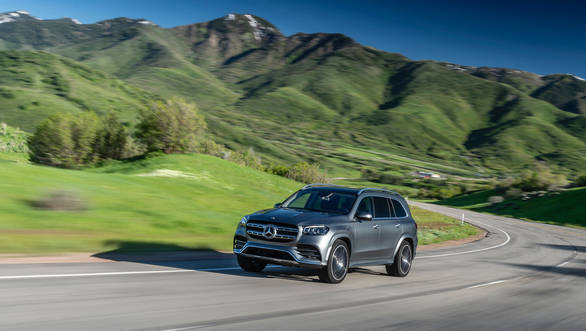 The E-ABC helps the GLS is maintaining a flat ride through corners, while the Surface Scan function helped it make quick amusements to the suspension damping to maintain a flat and supple ride
The E-ABC helps the GLS is maintaining a flat ride through corners, while the Surface Scan function helped it make quick amusements to the suspension damping to maintain a flat and supple ride
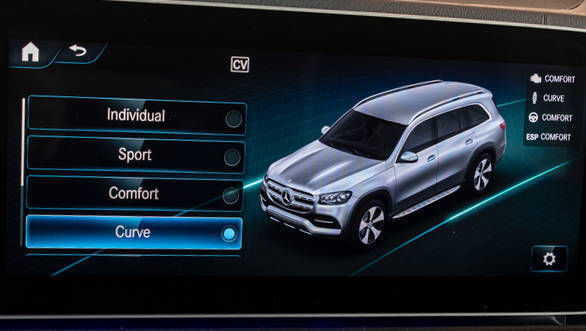 The E-ABC also features a Curve Control function that allows the GLS to 'tilt' into a corner by up to three degrees for better composure, thus eliminating body roll
The E-ABC also features a Curve Control function that allows the GLS to 'tilt' into a corner by up to three degrees for better composure, thus eliminating body roll
In comparison, the regular air-suspension, which comes standard on the GLS, is a bit squishy and makes the length of the GLS evident around bends. While the E-ABC does virtually shrink the size of the GLS around the twisties, it does little to reduce the vast turning radius of this mammoth. Rear-Axle steering would have helped. I believe that while the E-ABC is present on both, the GLE and the GLS, only the latter could make it available when the two cars come to India.
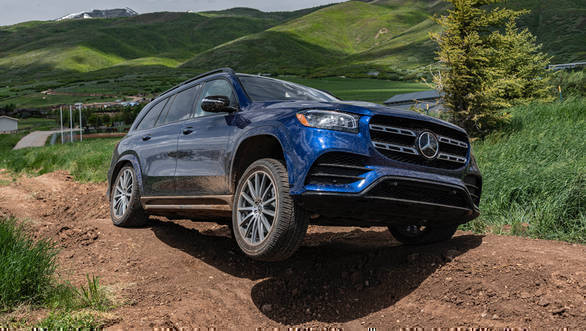 The individual wheel control of the E-ABC is a boon when articulating over rocks or undulations like these
The individual wheel control of the E-ABC is a boon when articulating over rocks or undulations like these
Enhanced off-road capability
The E-ABC is only one of the GLS' many capabilities and it can even rock the car out of sand and slush if the situation demands it. The third-generation GLS sharpens the already extensive off-road toolkit of the previous model. For starters, 4MATIC, which is the standard all-wheel-drive system for the GLS, is now designed to propel the car predominantly as a rear-wheel-drive and up to 50 per cent of the power and torque can be sent to the front if needed. Previously, the 4MATIC ran on a 50:50 split all the time. The new system is, therefore, more fuel efficient too and can also switch torque between the left and right wheels to aid grip - both on and off the road.
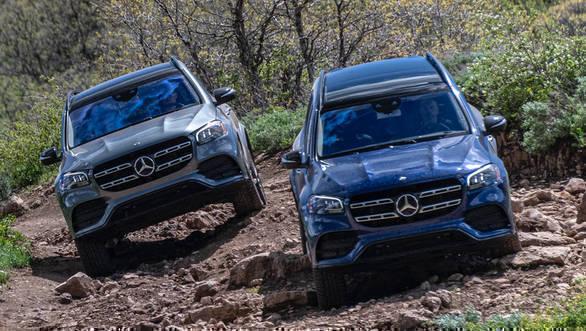 The new GLS is also more capable off the road than before, and the E-ABC helps big in that regard too
The new GLS is also more capable off the road than before, and the E-ABC helps big in that regard too
As before, the GLS features a centre differential lock, low-range ratios and a water-wading capability of 600mm, which isn't yet in the territory of the Range Rover, but very capable nevertheless. We drove on an ATV trail up and down the Wasatch Mountain State Park, passing through rocks, river, loose gravel and slush and the GLS impressed us quite a bit by effortlessly driving through all of it. Our test car on the trail was running all-season tyres and 20-inch rims, despite which, the E-ABC ensured a smooth and comfortable ride. In fact, the GLS did most of the trail in its basic Comfort mode, and only the trickier stuff like articulating over boulders, wading through the river, or descending down a steep slope, needed the GLS to pull out its Off-road mode and show off its adventure skills.
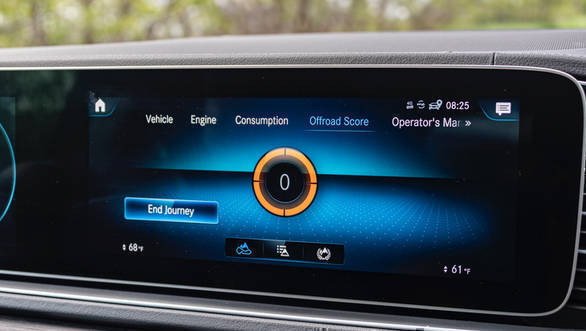 The new GLS also presents the driver with an off-road score - a fine piece of infotainment to go with the off-road expeditions!
The new GLS also presents the driver with an off-road score - a fine piece of infotainment to go with the off-road expeditions!
In fact, the new GLS will also judge the driver's skill at using these off-road tools, and present them with a score at the end of an off-road drive. We found this score to side with the idea of 'slow and steady wins the race' and it's a nifty piece of infotainment to go with your off-road drives. The question is though, would you like to scratch the expensive paint on your GLS by driving it into such forests? Mostly not, but having these capabilities is more of a feel-good appeal for your investment, and better peace of mind if you decide to go cross country with family.
 The new GLS has an approach angle of 29.4°, departure angle of 25.7°, breaker angle of 21.8° and a water wading capability of 600mm
The new GLS has an approach angle of 29.4°, departure angle of 25.7°, breaker angle of 21.8° and a water wading capability of 600mm
The new engines
With the generation change, the GLS also gets a host of new engines. The ones likely for India are the 3.0l inline-six petrol and diesel engines available in the GLS 450 and 400d guises, which respectively replace the current V6 powered GLS 400 and 350d with higher output and cleaner emissions. Both the engines are ready for BSIV operation, which isn't news anymore in the Mercedes-Benz stable.
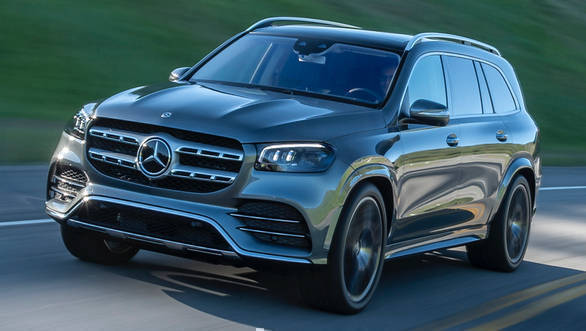 There are three new variants on the new GLS - a range topping GLS 580 petrol, a GLS 450 petrol and the diesel, which comes in the form of the GLS 400d
There are three new variants on the new GLS - a range topping GLS 580 petrol, a GLS 450 petrol and the diesel, which comes in the form of the GLS 400d
The diesel is likely to remain the volume generator even for the new GLS, and uses the same engine as the S350d but runs in a higher state of tune, feeding 330PS and 700Nm to the nine-speed gearbox. It has a fairly strong pull from the word go and does its city and highway duties extremely well. I won't call it the most refined engine in its class, but its practicality, reliability and high efficiency is hard to find faults with.
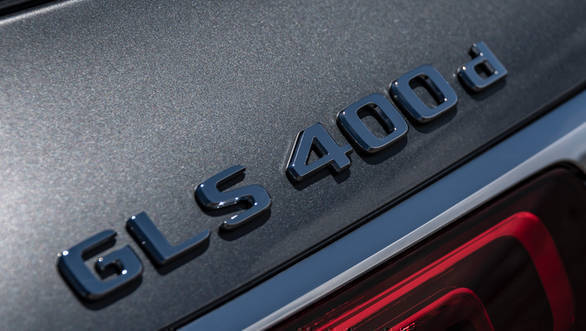 The GLS 400d replaces the current GLS 350d. It features a new, 330PS/700Nm 3.0l in-line six engine, that trumps the 3.0l V6 in the 350d, which is good for 255PS/620Nm
The GLS 400d replaces the current GLS 350d. It features a new, 330PS/700Nm 3.0l in-line six engine, that trumps the 3.0l V6 in the 350d, which is good for 255PS/620Nm
I would, however, go with the petrol option. The 367PS/500Nm in-line six engine in the GLS 450 is mated to an integrated starter generator which gives the drivetrain an additional 22PS of power and 250Nm of twist under the pretext of the EQ Boost function. The result is that the engine never feels strained, nor does it need to rev very high in order to build speed. It makes for a linear acceleration too, and the torque fill or assistance makes this car feel effortless and smooth when at slow city speeds - you don't have the jerky low-end that you experience in some of the competing SUVs. On the highway too, the assistance helps quite a bit and the available torque is more than enough to pull quick overtakes or cruise calmly. It is an extremely refined motor that goes with the premium character of the GLS, and it is, therefore, my choice of the two engine options.
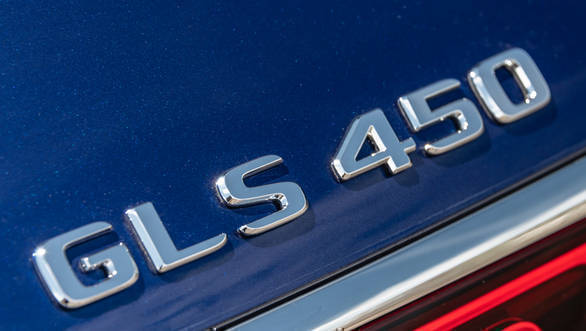 The GLS450 replaces the outgoing GLS400 with a new 3.0l in-line six engine that puts out 367PS/500Nm, which is punchier than the 330PS/480Nm output of the V6 in the outgoing GLS400
The GLS450 replaces the outgoing GLS400 with a new 3.0l in-line six engine that puts out 367PS/500Nm, which is punchier than the 330PS/480Nm output of the V6 in the outgoing GLS400
The cabin
With most of the GLSes being chauffeur driven, the power delivery or the driving aids are secondary factors. The heart of the matter, therefore, is the cabin - more so, the second and third rows. The third row is now more spacious than before and seats two adults in a fairly comfortable but knees-up position. The GLS comes in six and seven-seater configurations and the latter is likely to be the only option for India. Compared to the captain seats in the second row for the six-seater config, the seven-seater features a plusher bench with a centre armrest that stows an Android tablet with touchscreen functions for the climate control, massaging, window blinds etc. There are the conventional switches on the door too for adjusting reach and recline, but the tablet makes it cooler and also controls infotainment functions for the rear-seat Mercedes-Benz User Experience (MBUX).
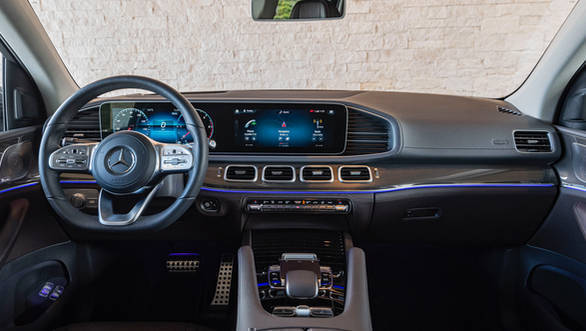 The cabin features an all-new design too. It features the twin-screen layout that is now common across all new-age Mercedes-Benz Cars
The cabin features an all-new design too. It features the twin-screen layout that is now common across all new-age Mercedes-Benz Cars
The MBUX for the front is an evolution of GLE's uber-cool system. Like the GLE, it lets you set different user profiles that customise air-conditioning, seating and the energising functions as per the user. There are gesture controls too, which are a tad bit more intuitive than the GLE and can differentiate between the front passengers to respond to commands accordingly. Similarly, even the voice commands have been enhanced with uni-directional mics on top of either front seats so that the system knows which of the two front occupants is speaking to it. For example, if the front passenger simply says, "I'm feeling hot", only the temperature on the passenger side will be dropped! We tried fooling the system, but it works almost flawlessly and understands Indian accents quite well.
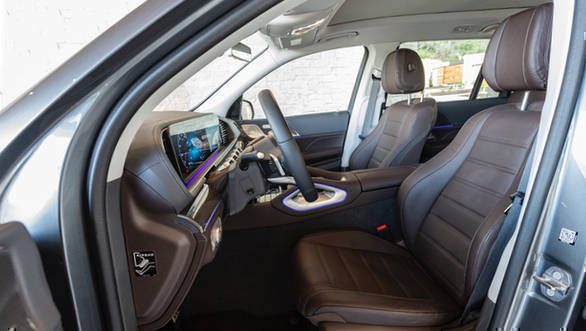 The front row sees a 5mm improvement in headroom, and a massive 21mm increase in shoulder room. Leg room remains unchanged
The front row sees a 5mm improvement in headroom, and a massive 21mm increase in shoulder room. Leg room remains unchanged
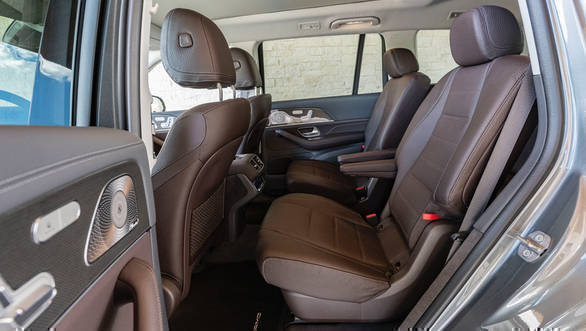 The second row has a 7mm improvement in headroom, a humongous 27mm improvement in legroom, and a 3mm increase in shoulder room.
The second row has a 7mm improvement in headroom, a humongous 27mm improvement in legroom, and a 3mm increase in shoulder room.
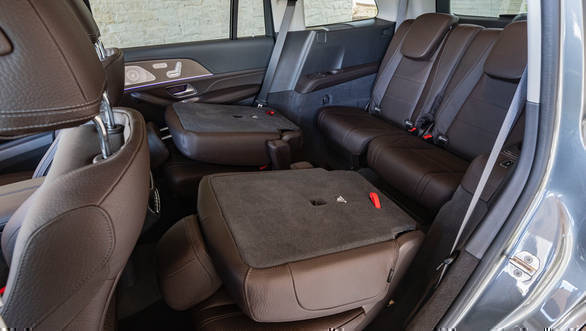 The third row isn't as roomy as the outgoing car. Headroom is unchanged, but legroom is down by 10mm, and shoulder room by 4mm
The third row isn't as roomy as the outgoing car. Headroom is unchanged, but legroom is down by 10mm, and shoulder room by 4mm
When can we try it?
We will be able to try most of these features first with the GLE, as the GLS, is expected to come sometime around the first quarter od 2020. The current model is still going strong for Mercedes-Benz and since its main draw remains its size, seating and comfort, it will continue to do so until the day the replacement arrives into India by the second quarter of 2020.
 Measuring 5,207x1,956x1,823mm, the new GLS is 77mm longer, 22mm wider and 27mm shorter than the outgoing model, which measures 5,130x1,934x1,850mm
Measuring 5,207x1,956x1,823mm, the new GLS is 77mm longer, 22mm wider and 27mm shorter than the outgoing model, which measures 5,130x1,934x1,850mm
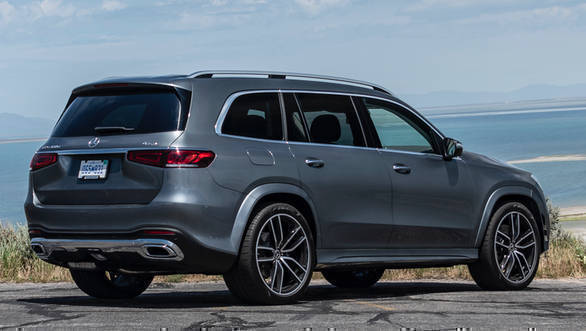 The 2020 Mercedes-Benz GLS has a wheelbase of 3,135mm, which is a massive 60mm longer than the second-gen GLS-Class
The 2020 Mercedes-Benz GLS has a wheelbase of 3,135mm, which is a massive 60mm longer than the second-gen GLS-Class
The new GLS scores big points on all those counts too, by being larger inside and out, and packing in a host of new creature comforts. It also looks sportier with its sleeker lines. Add to it the enhanced off-road capabilities and the trickery of the E-ABC, and you are looking at an all-rounder that justifies its punch line of being the S-Class of SUVs and then some.
Also see: 2020 Mercedes-Benz GLS First Drive Video Review
Starts Rs 99.9 Lakhs
2925cc
Automatic
330
700
-NA-
Related Stories
Top Stories
Latest Videos
Most Popular
- Budget Sportbike Showdown: Kawasaki Ninja 500 vs Aprilia RS 457 vs Yamaha YZF-R3
- 2014 Triumph Daytona 675 vs 2024 Kawasaki ZX6R - A Decade of Evolution in Supersport Motorcycles
- Mumbai-Pune Expressway speed restrictions updated
- Nissan Magnite EZ-Shift review - is the AMT any good?
- Nitin Gadkari states that tax on Hybrids should be reduced to 12 percent in the coming future
